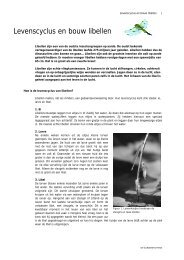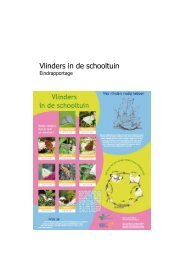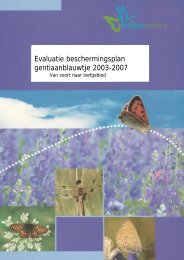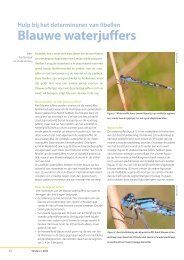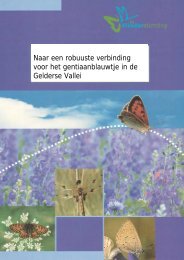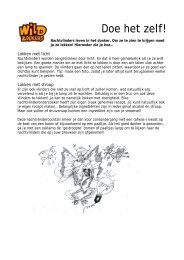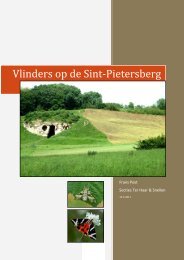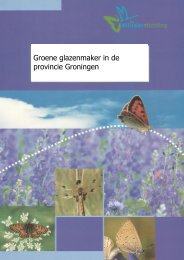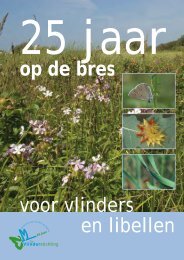Final Report October 2011 for the BBI-Matra/2008/015 ... - Vlindernet
Final Report October 2011 for the BBI-Matra/2008/015 ... - Vlindernet
Final Report October 2011 for the BBI-Matra/2008/015 ... - Vlindernet
You also want an ePaper? Increase the reach of your titles
YUMPU automatically turns print PDFs into web optimized ePapers that Google loves.
6.4. Summer camp <strong>for</strong> all butterfly watchers<br />
A week long butterfly watching camp in <strong>the</strong> South Kaçkars PBA attended by participants<br />
from across Turkey provided training in a wide range of butterfly identification and<br />
monitoring techniques delivered by several international experts and <strong>the</strong> opportunity to<br />
discuss <strong>the</strong> threats facing butterflies in this region.<br />
Details on <strong>the</strong> work:<br />
Between 19-25 July 2009, 19 butterfly watchers (13 of <strong>the</strong>m Turkish) joined a week of<br />
butterfly watching activities in <strong>the</strong> Kaçkar Mountains at Yusufeli. This area was selected<br />
because of its outstandingly rich butterfly fauna (it has since been identified as a Prime<br />
Butterfly Area) and because DKM has good local contacts and detailed knowledge of <strong>the</strong><br />
area, both of which made planning and logistics simpler.<br />
Turkish butterfly watchers participated from Ankara, Bursa, Çanakkale, Istanbul, Kars,<br />
Kayseri, Bitlis and Diyarbakır, and <strong>for</strong>eign experts joined (at <strong>the</strong>ir own expense) from <strong>the</strong><br />
USA, Belgium and <strong>the</strong> Ne<strong>the</strong>rlands.<br />
Daytime activities revolved around butterfly watching, photography, species identification<br />
and habitat-species relationships. In <strong>the</strong> evenings <strong>the</strong>re was time <strong>for</strong> data entry, butterfly<br />
identification workshops and butterfly conservation presentations, <strong>the</strong> latter largely given by<br />
<strong>the</strong> <strong>for</strong>eign experts. All were enthusiastically attended by <strong>the</strong> participants, and<br />
understanding and communication were greatly faciltated by Ezgi Akdesir, a PhD Veterinary<br />
student from Uludag University, who translated <strong>the</strong> <strong>for</strong>mal presentations. The talks<br />
provoked discussion about data sharing, <strong>the</strong> threats to <strong>the</strong> Kaçkars and what butterfly<br />
watchers could do to contribute to butterfly conservation.<br />
Problems encountered<br />
None<br />
Activity outputs and additional benefits<br />
o Kaçkar Camp <strong>Report</strong> and a selection of photos<br />
See 06.4 group in <strong>the</strong> annexes<br />
o Contacts were established between <strong>the</strong> Turkish and international butterfly watchers.<br />
o All participants went away with an increased awareness and appreciation of <strong>the</strong> Kaçkar region <strong>for</strong> butterflies.<br />
o Data collected during <strong>the</strong> camp was used <strong>for</strong> <strong>the</strong> Red Book and PBA work<br />
See Excel file in 06.4 group <strong>the</strong> annexes <strong>for</strong> a summary of <strong>the</strong> butterflies recorded (KackarCampBflyRecords)<br />
6.5. Butterfly network communication maintained on LepTR.org (i.e. via <strong>the</strong><br />
internet)<br />
Contact was maintained with <strong>the</strong> Turkish buterfly watching community via <strong>the</strong> internet and<br />
by <strong>the</strong> end of <strong>the</strong> project three new, independent web sites had been established.<br />
Details on <strong>the</strong> work:<br />
In a country <strong>the</strong> size of Turkey, effective national communication is only possible through<br />
use of <strong>the</strong> internet. At <strong>the</strong> start of <strong>the</strong> project, <strong>the</strong> butterfly watcher community was unified<br />
by <strong>the</strong> kelebek-gozlemciligi Yahoo group and <strong>the</strong> LepTR website. Here, questions were<br />
answered voluntarily by Ahmet Baytas, Evrim Karaçetin and <strong>the</strong> project assistant, with<br />
irregular input from Didem Ambarlı of DKM. When <strong>the</strong>se sites stopped functioning effectively<br />
(see activity 6.2) communication was largely restricted to emails, but by <strong>the</strong> end of <strong>the</strong><br />
project three new independent websites had been established which fulfilled <strong>the</strong> functions<br />
of <strong>the</strong> original e-group and website, without <strong>the</strong> need <strong>for</strong> input from <strong>the</strong> project team.<br />
The internet was also used to keep in touch with <strong>the</strong> butterfly watcher community about <strong>the</strong><br />
project: <strong>for</strong> example promoting <strong>the</strong> Butterfly Watchers’ Workshop (Feb 2009), <strong>the</strong> Kaçkar<br />
Camp (July 2009) and <strong>the</strong> International Camp in Hungary (May <strong>2011</strong>).<br />
DE VLINDERSTICHTING & BCE <strong>2011</strong> | Butterfly Conservation in Turkey – <strong>Final</strong> report <strong>2011</strong> 45







